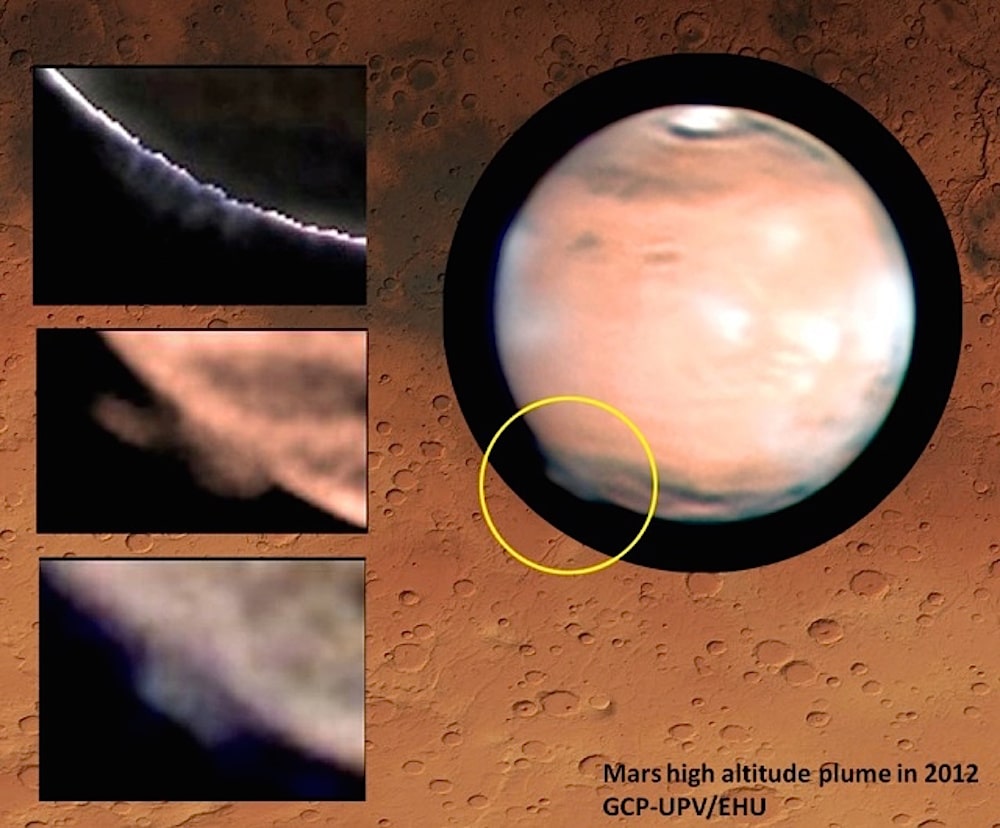Agustín Sanchez-Lavega es un astrofísico, investigador de la Universidad del País Vasco (UPV/EHU) que no nos resulta «desconocido». En 2011 le citábamos porque había liderado en un estudio sobre la Great White Spot (GWP) de Saturno.
Hoy, casi 4 años después, le volvemos a citar porque otro estudio en el que ha participado está atrayendo la atención de medios de comunicación internacionales. En esta ocasión se trata del análisis de un fenómeno que ha ocurrido en Marte y que ha dejado a los científicos totalmente desconcertados.
En febrero de 2012, astrónomos aficionados de todo el mundo captaban una imagen que les dejó sorprendidos: de la superficie de Marte emergía un penacho de 250 kilómetros de altitud, un fenómeno que se repitió un mes después, y del que ahora, 3 años después, los científicos que lo están investigando se atreven a pronunciarse con las primeras hipótesis de trabajo sobre su origen. El material facilitado por los aficionados ha servido para poder analizar el suceso y, sobre todo, para indagar un poco más en la atmósfera de Marte, de la que todavía se sabe muy poco.
Unas hipótesis que han sido comunicadas a la sociedad científica a través de una publicación de la revista Nature y que recoge las conclusiones de un trabajo en el que han participado científicos de la Universidad del País Vasco y del Consejo Superior de Investigaciones Científicas. El artículo plantea dos hipótesis: que se trate de una nube formada por partículas -o cristales- de hielo o de dióxido de carbono, o que sea un fenómeno luminoso semejante a una aurora boreal.
El fenómeno, que tiene desconcertados a los científicos es descrito por Agustín Sánchez-Lavega, el autor del estudio e investigador del grupo de Ciencias Planetarias de la UPH/EHU, como un penacho no uniforme que horizontalmente midió entre 500 y mil kilómetros, «casi el tamaño de la península«, y que verticalmente, «durante dos días alcanzó una altura de 200-250 kilómetros, algo totalmente inédito«.
Son medios de todo el mundo los que lo incluyen entre sus informaciones. Recogemos aquí directamente a algunos e incluimos otros de relevancia (como siempre sin voluntad de ser exhaustivos) en nuestro servicio scoop.it
National Geographic -16/2/2015 – USA
Bizarre Martian Plumes Discovered by Amateur Astronomers

An international network of amateur astronomers has spotted what looks like two plumes, or slender, cloudy projections, extending from the surface of Mars, and their professional counterparts have no clear idea of what they might be. «Any explanation we can think of challenges our understanding of the upper atmosphere of Mars,» says Agustín Sánchez-Lavega, a professional astronomer at the University of the Basque Country, in Bilbao, Spain, and lead author of a report on the phenomenon in the journal Nature.
(Sigue) (traducción automática)
———————————–
Ars Technica – 16/2/2015 – USA
Strange show spotted high above Mars’ surface remains mysterious
Almost three years ago, the Red Planet put on a bit of a show for anyone with a telescope big enough, and an eye trained enough, to spot it. As the Terra Cimmeria region of Mars’ Southern Hemisphere rotated into view, a faint bulge rose above the smooth curve of the planet’s surface. It looked like a cloud, but it was too tall and too weird. Starting on March 12, 2012, amateur astronomers reported seeing the odd lump on the Martian horizon. Reports continued to pour in over the next 11 days as the lump became even more obvious. It petered out some time before April 1, but a second occurrence was observed between April 6 and April 16. Each time, its form varied from day to day, and it was seen as dawn swept across the region—but not at dusk.
(Sigue) (traducción automática)
———————————–
Discovery News – 16/2/2015 – USA
Mysterious Mars Plumes Defy Explanation
(Sigue) (traducción automática)
———————————–
RAI – 16/2/2015 – Italia
Nuvole misteriose su Marte, gli astronomi si interrogano sulle cause
(Sigue) (traducción automática)
———————————–
NDTV – 16/2/2015 – India
Cloud’ over Mars Leaves Scientists Baffled
Paris: Amateur astronomers have spotted two strange, cloud-like plumes high over Mars, deepening the mystery of what constitutes the Red Planet’s atmosphere, a study said today. The phenomenon was observed on March 12, 2012 over the «terminator», the boundary between day and night on Mars. One of the plumes developed in around 10 hours and lasted for about 11 days, shifting shape from «double blob protrusions» to pillars which merged into a «finger», the study authors wrote. A second was spotted nearby on April 6, 2012, and lasted about 10 days.
(Sigue) (traducción automática)
———————————–
Mas referencias en Scoop.it
Last Updated on Feb 24, 2015 by About Basque Country































